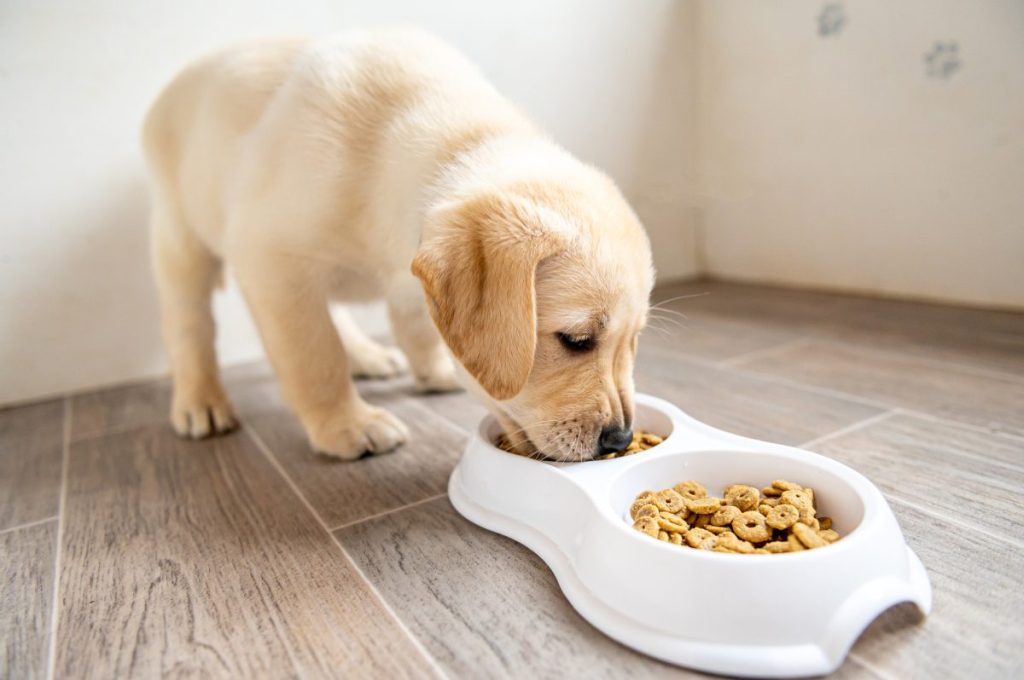A puppy eats a lot of food. From birth up to 6 months of age, they’ll need to eat two to four times as much as an adult dog to support all that growth. A good rule of thumb (paw?) is that after their first week of life, when their weight doubles from what it was at birth, a puppy should gain 1 to 2 grams per pound of anticipated adult weight each day. This means that if your German Shepherd puppy weighs 75 pounds as an adult, they should gain 3 to 5 ounces per day as a puppy.
What kind of food should you feed your puppy
Generally speaking, puppy food is higher in protein and enriched with vitamins, minerals, and fats essential for growth when compared to adult dog food made by the same manufacturer. Still, ingredients across brands can vary greatly. Commercial puppy food must meet AAFCO (Association of American Feed Control Officials) nutrient standards for growth, and many companies go above and beyond those standards, testing their products to make sure they support puppies’ development.
They don’t have to, though; they’re only required to meet the minimum nutrient standards. In most cases, you get what you pay for. Lower-quality ingredients are found in the cheaper brands while “premium” and “performance” varieties include higher-quality ingredients for improved digestibility.
Buy “puppy food”
It’s more likely to have the extra nutrients a puppy needs until they’re full grown. Ask your vet for guidelines on when that might be. Small dogs mature more quickly than big dogs.
Regular food labeled “for all life stages” is fine, too.
Consider breed-formulated food
Large-breed puppy formulas help bigger pups grow at a rate gradual enough that they have time to develop strong bones and joints. Small-breed formulas provide concentrated nutrition in small, bite-size kibbles that meet a smaller puppy’s high metabolic needs. And, yes, medium-breed formulas aim somewhere in between. If you can’t find breed-formulated food, that’s OK.
How much food should I give my puppy
Puppies need to eat a lot, but not too much. You should be able to feel but not see their ribs, and they should have a visible waist when you look down at them. This is true for puppies of any breed, big or small.
In general, you should follow the guidelines on the bag of dog food, and adjust up or down depending on your puppy’s appetite and body condition.
When should I feed my dog
At around 8 to 12 weeks of age, your puppy is probably eating three to four times a day. However, they don’t have to eat that many times. If it suits your schedule to feed them only twice a day, just divide the amount of food you’d normally give into two meals instead of three or four.
After your puppy is 6 months old, you can (and should) reduce the number of meals you feed them to two. Start reducing the amount of food they get as well, following guidelines provided by food manufacturers and adjusting as needed. If you’re feeding too much, most dogs will let you know by leaving some food behind in their bowl.
Considerations for feeding puppies
- Large-breed puppies need slow, sustained growth to help prevent orthopedic problems, such as hip dysplasia. Raise them on a diet designed for large-breed dogs or food for adult dogs. Whatever diet you choose shouldn’t overemphasize protein, fat, and calorie levels.
- Small but chunky breeds, such as Pugs, also need a lower-calorie diet than what’s provided by most puppy foods, because they’re also prone to hip dysplasia.
- Feed your dog at set times each day rather than free feeding so they learn a schedule. The exceptions are tiny breeds such as Chihuahuas, who can be prone to hypoglycemia (low blood sugar). They should always have food available to nibble on.
- Never feed your puppy from the table. It only encourages begging. Everyone in the family must follow this rule.
Now that you know how to feed your puppy, check out our tips on housetraining your fur baby, as well as cool tricks you can teach your little canine companion!









